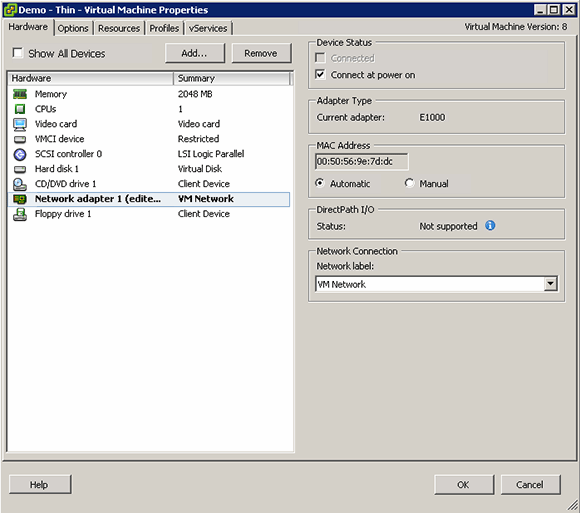To set a static MAC address for a virtual machine, you can edit the configuration file of the virtual machine by using the vSphere Web Client.
- Locate the virtual machine in the vSphere Web Client.
- Select a data center, folder, cluster, resource pool, or host and click the Related Objects tab.
- Click Virtual Machines and select the virtual machine from the list.
- Power off the virtual machine.
- On the Manage tab of the virtual machine, select Settings.
- On the VM Options tab, expand Advanced.
- Click Edit Configuration.
- To assign a static MAC address, add or edit parameters as required.
Parameter Value ethernetX.addressType static ethernetX.address MAC_address_of_the_virtual_NIC X next to ethernet stands for the sequence number of the virtual NIC in the virtual machine.
For example,0in ethernet0 represents the settings of the first virtual NIC device added to the virtual machine. - Click OK.
- Power on the virtual machine.

In most network deployments, generated MAC addresses are appropriate. However, you might need to set a static MAC address for a virtual network adapter.
To set a static MAC address for a virtual machine, you can edit the configuration file of the virtual machine by using the vSphere Web Client. By default, static MAC addresses have the VMware Organizationally Unique Identifier (OUI) as the prefix. However, the range of free address provided by the VMware OUI is restrictions. Assign a Static MAC Address with the vSphere Web Client You can assign static MAC addresses to the virtual NIC of a powered off virtual machine by using the. When you create a VM on VMware ESXi, each network interface of the VM is assigned a dynamically generated MAC address. If you want to change this default behavior and assign a static MAC address to your VM, here is how to do it.
The following examples show when you might set a static MAC address.
Manual Mac Address Vmware Server
Virtual network adapters on different physical hosts share the same subnet and are assigned the same MAC address, causing a conflict.
■ | You want to ensure that a virtual network adapter always has the same MAC address. |

By default, VMware uses the Organizationally Unique Identifier (OUI) 00:50:56 for manually generated addresses, but all unique manually generated addresses are supported.
If you choose to use the VMware OUI, part of the range has been partitioned for use by vCenter Server , host physical NICs, virtual NICs, and future use.
You can set a static MAC address using the VMware OUI prefix by adding the following line to a virtual machine‘s configuration file:
In the example, <number> refers to the number of the Ethernet adapter, XX is a valid hexadecimal number between 00 and 3F, and YY and ZZ are valid hexadecimal numbers between 00 and FF. The value for XX cannot be greater than 3F to avoid conflict with MAC addresses that are generated by the VMware Workstation and VMware Server products. The maximum value for a manually generated MAC address is shown in the sample.
Mac Address Lookup
You must also set the address type in a virtual machine’s configuration file.

Because ESXi virtual machines do not support arbitrary MAC addresses, you must use the example format. Choose a unique value for XX:YY:ZZ among your hard-coded addresses to avoid conflicts between the automatically assigned MAC addresses and the manually assigned ones.
It is your responsibility to to ensure that no other non-VMware devices use addresses assigned to VMware components. For example, you might have physical servers in the same subnet, which use 11:11:11:11:11:11, 22:22:22:22:22:22 as static MAC addresses. Since the physical servers do not belong to the vCenter Server inventory, vCenter Server is not able to check for address collision.